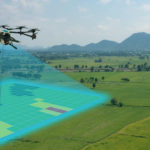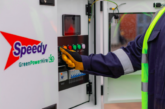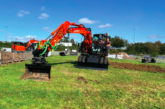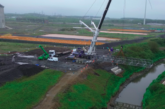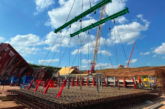A consortium of 16 entities led by specialist drone command & control solution developer, sees.ai, including construction and infrastructure giants Skanska, Skanska Costain STRABAG working in partnership with HS2 and Atkins has won a share of £30 million to develop and test a remotely operated drone system for industrial and urban environments.
The funding comes from the Future Flight Challenge, Phase 2 competition, part of the Industrial Strategy Challenge Fund, delivered by UK Research and Innovation
The futuristic system will enable remote inspection and monitoring of urban sites in the public domain e.g. construction sites, industrial sites (nuclear and oil & gas), road & rail and telecoms infrastructure, and enable live emergency services support.
The system, which uses similar technology to autonomous cars, enables highly automated drones to be flown under tight human supervision by pilots based in a central control room hundreds of miles away. Pilots can precisely execute complex missions remotely – even reactive missions (designed on-the-fly) and close-quarter missions encountering GPS-denial, magnetic interference and degradation & loss of comms.
Congested area operations are very challenging, but the potential reward for unlocking these types of mission in terms of public health & safety, cost efficiency and environmental impact is huge. No single entity could make this happen alone, so this consortium of aviation, aerospace, industrial and emergency service giants, together with www.sees.ai has joined forces to advance the system and integrate it into the wider aviation ecosystem.
Technical contributors to the consortium are: NATS, Vodafone, BAE Systems, The Met Office, Flock Cover, UAM Consult Ltd and University of Bristol Smart Internet Lab.
The project involves the system being put through a series of tests, increasing in complexity and challenge, with end-client organisations: Skanska; Skanska Costain STRABAG working in partnership with HS2; Sellafield; Lancashire Fire and Rescue Service; Vodafone; Network Rail; and Atkins. During these tests the system will be operated by two of the world’s leading drone service providers, Terra Drone and Sky-Futures or by the in-house drone teams at Sellafield, Network Rail, and Lancashire Fire and Rescue Service.
Felipe Manzatucci, Digitalisation Director for Skanska UK said: “Carrying out inspections and monitoring activities using drones has already proven to be a valuable way to safely access accurate, real-time data on construction activities. Being able to do this remotely, without the need for teams of specialist drone operators on site will reduce costs and increase the speed in which these activities can be deployed. We are really excited to be part of this consortium and help realise these efficiency benefits for Skanska, our customers and the wider construction industry.”
Harrison O’Hara, Innovation Manager Skanska Costain STRABAG Joint Venture said: “It’s exciting to be part of this trial to safely fly drones beyond visual line of sight in industrial environments. Although drones are by no means a new concept they are still far from business as usual and we are only just scratching the surface of their potential. We are always looking at new ways to improve safety, work more efficiently and deliver a world leading project such as HS2. It’s great to be working with a pioneering company such as sees.ai to support our existing capabilities.”
John McKenna, CEO of sees.ai said: “The Future Flight Challenge funding will accelerate us towards a future where drones fly autonomously at scale – high up alongside manned aviation and low down inside our industrial sites, suburbs and cities. Unlocking the safe and remote operation of drones in urban and industrial locations will deliver huge benefits to society across public health & safety, efficiency and environmental impact.
We are enormously proud to be leading this consortium and to be working with such incredible partners to develop this advanced Beyond Visual Line of Sight (BVLOS) aviation system.”
Gary Cutts, Future Flight Challenge Director said: “At this very challenging time for the international aviation industry, it is a great testament to the UK’s drive and ambition that we have had such a strong response to the first funded Future Flight competition. The breadth, quality and creativity of the bids has been exceptional and the economic and social benefits offered are very significant. The projects we are now launching will position the UK strongly to drive the 3rd revolution in aviation.”

